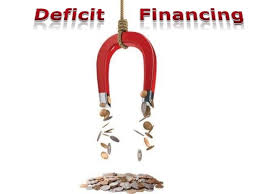Deficit Financing – how governments overspend and create revenue to bridge the gap
The practice of a government spending more than the revenue it obtains from taxes, surpluses of public sector enterprises, fees is called DEFICIT
The gap between revenue and expenditure or the resource gap may be filled up by:-
(1) Borrowing from commercial banks
(2)Drawing down of cash reserves of the RBI
(3)Issue or printing of additional currency
This policy of deficit financing is a deliberately created resource gap between public revenue and public expenditure or a budgetary deficit so as to finance the net addition to national outlay. In other words, deficit financing puts extra purchasing power in the hands of the public. It is one of the important instruments of planning for economic development.
Through deficit financing there may be a temporary disequilibrium between the supply of money and the supply of output. But it is argued that this policy is not harmful as long as supply of goods and services increases. If investments are directed to the breakdown of delays in increased production, then deficit financing will not be inflationary as the general price level will not rise much. When the spending is done on unproductive sources, the expected increase in output will not take place and hence will lead to inflation.
CASE FOR DEFICIT FINANCING:-
(1)Increasing the rate of net investment
(2)Building of social overhead capital such as railways, roads, educational institutions
(3)Leads to investment of forced savings of the public
(4)Necessary in a developing economy for public needs more money for transactionary and precautionary purposes
(5)To meet the increased demand for money through increase in money supply to match an import surplus
CASE AGAINST DEFICIT FINANCING:-
(1)It sometimes sows the seeds of inflation which is harmful in less developed or developing countries. In some cases the persistent rise in prices may lead to hyper-inflation.
(2)Does not encourage saving and investment in free-market underdeveloped economies
(3)Use of deficit financing for infrastructure development is bound to be inflationary because investment in infrastructure development is slow to give yields.
(4)It makes food problems more critical. This is because in underdeveloped or developing economies which are mostly agriculture based, an increase in income through deficit financing will lead to demand- supply gap in agricultural commodities leading to sharp increase in prices. This increase in price of agricultural commodities percolates to other sectors also.
Hence we can conclude that developing economies are extremely sensitive and can tolerate only a mild dose of deficit financing. Therefore, there should be some safe limits to deficit financing.
Click here for government certification in Accounting, Banking & Finance





24 Comments. Leave new
Well explained. Truly, the governments shall work with responsibility, else the consequences can be really dangerous!
Well described.
well researched.
informative
Nice points! Keep going!
Very well written!
nice one
Very well written. Good effort!
Got something new to read 😀
it seemed a bit interesting to me that cycle flow of money from government to public and vise-versa 😀
Nice work 😀
You have covered all points very well
Very well explained!
nicely explained
Very well-explained article! Good argument presented! Keep it up!
Informative!
The government has to incur this to save the economy from the perils of recession, very well written , commendable
Informative
very informative 🙂
good points 🙂
Thank you everyone. 🙂
nice posts and informative too
Nice!
Nicely written 🙂
Great work
Nice work ….
Great article!